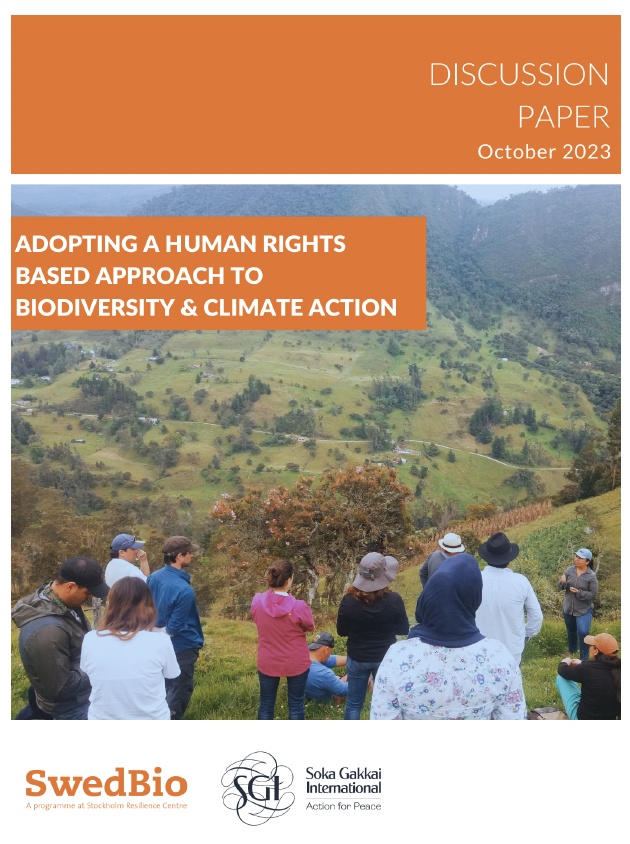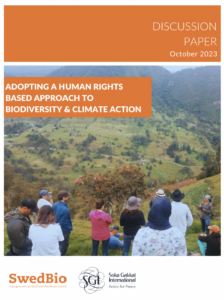 Story highlights
Story highlights
- A human rights-based approach (HRBA) is essential to address biodiversity and climate challenges
- HRBA are present in different policy processes (e.g. the ongoing SBSTTA25 negotiations)
- The case studies in this publication demonstrate how a HRBA for climate and biodiversity action can contribute to living in harmony with nature.
There are several key opportunities to guide more ambitious national actions that address climate change and biodiversity loss in an integrated manner, reduce harm, ensure fairness and justice for all.
Read the full discussion paper here.
These opportunities are present in different policy processes not least at the currently ongoing negotiations of the Biodiversity and Climate Change agenda during the 25th meeting of the Subsidiary Body on Scientific, Technical and Technological Advice (SBSTTA 25) in Nairobi under the Convention on Biological Diversity (CBD).
The diverse case studies in this publication demonstrate how adopting a HRBA for climate and biodiversity action can lead to more successful and sustainable outcomes in achieving the goal of living in harmony with nature.
Key messages for implementation are:
Strengthen the enabling environment and enhance the capacity and accountability of duty bearers.
Enhance the meaningful participation of and engagement with communities and people disproportionately impacted by biodiversity loss and climate change, and promote their leadership in interventions to ensure positive and sustainable outcomes for both people and the ecosystems on which they depend.
Emphasise the need to strengthen environmental and social safeguards, to ensure the respect, protection, promotion and fulfilment of human rights, including the right to a healthy environment, while addressing the power inequalities that generate abuse of human rights and enhancing access to justice.
Underscore the need to respect Free, Prior and Informed Consent, and/or other consent mechanisms of Indigenous Peoples and local communities.
Facilitate the integration and/or revitalisation of traditional and indigenous knowledge and management systems, which have effectively safeguarded the biodiversity of the area.
Recognise the context-specific nature of challenges.
Identify power, political, and gender dynamics that affect biodiversity and climate action, and promote ways to identify previously invisible impacts and address differentiated needs as well as conflicting rights and interests.
Foster adaptive capacity, facilitating, and valuing communities’ ability to monitor and address future environmental issues.
Key messages for relevant international policy processes are:
Integrate a HRBA when clarifying the standards and criteria for implementation of Nature-based Solutions (NbS) in the context of the Intergovernmental Consultations on NbS.
Recognise the impacts of climate change and biodiversity loss on human rights in the context of the negotiations of the Biodiversity and Climate Change agenda under the CBD SBSTTA 25.Integrate the need to adopt a HRBA when considering Ecosystem-based Approaches and NbS, recognise rights holders, including Indigenous Peoples and local communities, women and girls, children and youth, people with disabilities among others.
Ensure that the Global Stocktake process calls for integrated climate and biodiversity actions and policies, implemented through a HRBA In the context of COP28.


 Adopting a Human Rights-based Approach to Biodiversity and Climate Action_layouted_161023_FINAL
Adopting a Human Rights-based Approach to Biodiversity and Climate Action_layouted_161023_FINAL DISCUSSION PAPER: Adopting a human rights-based approach to biodiversity and climate action
DISCUSSION PAPER: Adopting a human rights-based approach to biodiversity and climate action Ashanapuri Hertz
Ashanapuri Hertz